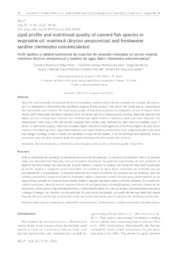Perfil lipídico y calidad nutricional de especies de pescado enlatadas en aceite vegetal: matrinxa (Brycon amazonicus) y sardina de agua dulce (Hemiodus unicamculatus).
Perfil lipídico y calidad nutricional de especies de pescado enlatadas en aceite vegetal: matrinxa (Brycon amazonicus) y sardina de agua dulce (Hemiodus unicamculatus).
Author(s): PIRES, C. R. F.; SILVA, C. D. M. da; SOUSA, D. N. de; CHICRALA, P. C. M. S.; SANTOS, V. F. dos
Summary: Given the need to satisfy the demand for fish consumption, canned native fish has emerged as a market alternative, but it is necessary to determine the nutritional aspects of this product. The aim of this study was to characterise the lipid profile and evaluate the nutritional quality of matrinxã preserved in vegetable oil and compare these results with freshwater sardines obtained from the same type of processing and canning. Matrinxã species had higher protein content than sardines, but sardines had higher levels of moisture, lipids and total minerals. The predominant fatty acid in the canned fish samples was linoleic acid, followed by oleic acid and palmitic acid. In terms of nutritional quality, matrinxã showed higher indices of atherogenicity and thrombogenicity and lower values of the following ratios: hypocholesterolemic and hypercholesterolemic fatty acids; polyunsaturated/saturated and omega 6/omega 3 ratio in relation to sardines. In view of the results, it can be affirmed that Matrinxã, from a nutritional point of view, presents itself as a good alternative for the canned fish industry.
Publication year: 2023
Types of publication: Journal article
Observation
Some of Embrapa's publications are published as ePub files. To read them, use or download one of the following free software options to your computer or mobile device. Android: Google Play Books; IOS: iBooks; Windows and Linux: Calibre.
Access other publications
Access the Agricultural Research Database (BDPA) to consult Embrapa's full library collection and records.
Visit Embrapa Bookstore to purchase books and other publications sold by Embrapa.

